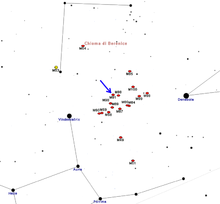- Messier 91
-
Messier 91 
Spiral Galaxy M91Observation data (J2000 epoch) Constellation Coma Berenices Right ascension 12h 35m 26.4s[1] Declination +14° 29′ 47″[1] Redshift 486 ± 4 km/s[1] Distance 63 ± 16 Mly (19 ± 5 Mpc)[2] Type SBb(rs)[1] Apparent dimensions (V) 5′.4 × 4′.3[1] Apparent magnitude (V) 11.0[1] Other designations NGC 4548,[1] UGC 7753,[1] PGC 41934[1] See also: Galaxy, List of galaxies Messier 91 (also known as NGC 4548 or M91)[3][4] is a barred spiral galaxy located in the Coma Berenices constellation and is part of the Virgo Cluster of galaxies. M91 is about 63 million light-years away from the earth. It was the last of a group of eight nebulae discovered by Charles Messier in 1781. Originally M91 was a missing Messier object in the catalogue as the result a bookkeeping mistake by Messier. It was not until 1969 that amateur astronomer William C. Williams[3] realized that M91 was NGC 4548,[4] which was documented by William Herschel in 1784.
Contents
Observation history
Messier 91 was discovered on the night of March 18, 1781, Charles Messier described it as Nebula without stars, fainter than M90. Messier mistakenly logged its position from Messier 58,[4][5] where in fact it should have been Messier 89. William Herschel observed the same galaxy on April 8, 1784, describing it as a beautiful but faint 11.3 magnitude barred spiral. Williams solved the missing Messier object by measuring its right ascension and declination relative to those of the nearby galaxy M89 (there are no suitable reference stars in the vicinity). Williams applied the observed differences of M91 with M58, a 9th-magnitude galaxy which Messier recorded in 1778. The calculation reproduces the Messier position[3] to 0.1' in right ascension and 1' in declination.
Features
The inclusion of Messier 91 in the Virgo Cluster of Galaxies was confirmed by detecting Cepheid variables[4] when a recent measurement was done. M91’s bar is very conspicuous where it lies at an angle of 65/245 degrees when being measured from the North direction to the East. There is a considerable peculiar velocity[4] toward us through the Virgo cluster of about 700 km/s while the cluster's recession velocity is about 1100 km/s, this ultimately pegs its recessional velocity to only about 400 km/s.
References
- ^ a b c d e f g h i "NASA/IPAC Extragalactic Database". Results for NGC 4548. http://nedwww.ipac.caltech.edu/cgi-bin/nph-objsearch?objname=M+91&extend=yes&out_equinox=J2000.0. Retrieved 2006-12-13.
- ^ J. L. Tonry, A. Dressler, J. P. Blakeslee, E. A. Ajhar, A. B. Fletcher, G. A. Luppino, M. R. Metzger, C. B. Moore (2001). "The SBF Survey of Galaxy Distances. IV. SBF Magnitudes, Colors, and Distances". Astrophysical Journal 546 (2): 681–693. arXiv:astro-ph/0011223. Bibcode 2001ApJ...546..681T. doi:10.1086/318301.
- ^ a b c William C. Williams Letter, Sky and Telescope, December 1969, p. 376. Accessed 13 April 2011
- ^ a b c d e Students for the Exploration and Development of Space Messier 91, Accessed online 14 April 2011
- ^ "Messier 91". University Today. http://www.universetoday.com/48349/messier-91/. Retrieved 2010-04-14.
External links
- Messier 91 on WikiSky: DSS2, SDSS, GALEX, IRAS, Hydrogen α, X-Ray, Astrophoto, Sky Map, Articles and images
Coordinates:
 12h 35m 26.4s, +14° 29′ 47″
12h 35m 26.4s, +14° 29′ 47″Messier objects List M1 · M2 · M3 · M4 · M5 · M6 · M7 · M8 · M9 · M10 · M11 · M12 · M13 · M14 · M15 · M16 · M17 · M18 · M19 · M20 · M21 · M22 · M23 · M24 · M25 · M26 · M27 · M28 · M29 · M30 · M31 · M32 · M33 · M34 · M35 · M36 · M37 · M38 · M39 · M40 · M41 · M42 · M43 · M44 · M45 · M46 · M47 · M48 · M49 · M50 · M51 · M52 · M53 · M54 · M55 · M56 · M57 · M58 · M59 · M60 · M61 · M62 · M63 · M64 · M65 · M66 · M67 · M68 · M69 · M70 · M71 · M72 · M73 · M74 · M75 · M76 · M77 · M78 · M79 · M80 · M81 · M82 · M83 · M84 · M85 · M86 · M87 · M88 · M89 · M90 · M91 · M92 · M93 · M94 · M95 · M96 · M97 · M98 · M99 · M100 · M101 · M102 · M103 · M104 · M105 · M106 · M107 · M108 · M109 · M110See also  Book:Messier objects ·
Book:Messier objects ·  Category:Messier objects
Category:Messier objects  Portal:AstronomyCategories:
Portal:AstronomyCategories:- Spiral galaxies
- Barred spiral galaxies
- Virgo Cluster
- Coma Berenices constellation
- Messier objects
- NGC objects
- UGC objects
- PGC objects
Wikimedia Foundation. 2010.

